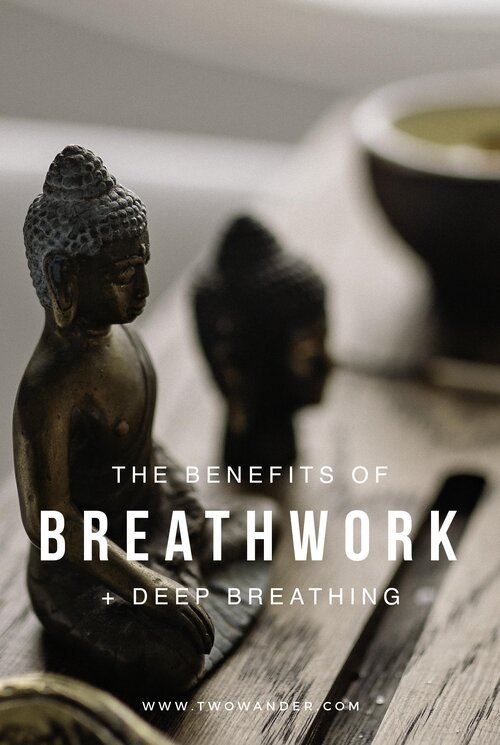Breathwork And The Benefit Of Deep Breathing
This post may contain affiliate links. If you choose to purchase through these links, we may receive a small commission at no extra cost to you. By using these links you are directly supporting us to continue creating Holistic Wellness and Mystical Musings. Thank you!
Breathwork And The Benefit Of Deep Breathing
Breathwork is an incredible practice that can quickly soothe the nervous system and restore us to the parasympathetic state, instilling a sense of calm, groundedness, and alertness. It is easy to do and accessible at many moments throughout the day, making it a preferred choice for some people who struggle to sit still for meditation. When used in conjunction with mediation, yoga, sound baths, and other healing modalities, its effects can be profound.
I started doing breathwork about a year ago and absolutely love it, I use it regularly alongside my other spiritual and mental health practices. There are many different types of breathwork, if you practice yoga you will be familiar with some of the Pranayamas (such as Ujjayi, Nadi Shodhana etc.), there is also Shamanic breathing, Soma breathing, Holotropic breathwork, Rebirthing breathwork, Transformational breathing, the Wim Hof technique, and other techniques such as Box Breath, 4-7-8 breathing, and more!
Many of these stem from Ancient rituals practiced in India, Southern America, and other cultures, while some were developed off of them or reinvented entirely. More and more studies point to their efficacy for stress response, anxiety control, easing panic attacks and fatigue, increasing stamina, endurance and concentration, and many, many more benefits! Certain practices, such as with Kundalini yoga, practice in a way to activate the pineal gland, open up your Third Eye Chakra, and help you connect to your Spirituality. They are said to be able to help dissolve your ego and bring a sense of connection, inner peace, and balance.
For an astrological breathwork practice compatible with the energy of the season and aligned with the characteristics of the current Zodiac Sign, check out our Seasonal Zodiac Workbooks!
How To Do Breathwork
Breathwork is a practice of usually sitting or lying down, but you can also do certain ones throughout the day, and intentionally changing your breathing pattern for a desired outcome that can either be for a physical, mental, spiritual, or combination effect. You can do just a couple of rounds of breath or go for up to an hour or more in some exercises. As everyone’s bodies and sensitivities are different, you may experience different things during a breathwork practice, which can commonly include dizziness, light-headedness, tingling sensations, changes in temperature, rapid heartbeat, or even shortness of breath if done incorrectly.
Breathwork is a safe healing modality as you are in control and can stop at any time, however, extra care should be taken if you suffer from any health conditions and it is always best to speak to your health practitioner beforehand (especially if pregnant)! Some practices, such as Holotropic, Rebirthing, Shamanic, and Transformational, are usually done in a guided setting by an experienced practitioner to facilitate the experience, and can be quite intensive for some. Others, such as Wim Hof’s, have their own app you can follow along with if you like (this is how I used to do it), and, of course, most Yoga practices will include some form of Pranayama in their sessions.
Breathwork can help with:
anger issues
Supporting a healthy immunity
chronic pain
process feelings, heal emotional pain, PTSD and trauma
increase self-awareness
enhance creativity
assist with self-esteem and happiness
reduce stress and anxiety levels
release negative thought patterns
As mentioned, there are numerous different breathwork techniques in existence today used for a variety of reasons, but here are some of the most popular:
1. Pranayama
Prana means “breath”, or life energy, and Yama means “control”. If you practice yoga, it’s likely you’ve experienced at least one of the following. All of them are great for bringing emotional harmony and clearing energetic blocks, and should always be practiced on an empty stomach if possible. Known as one of the fundamental 8 limbs of Yoga (along with the asana/poses) Pranayama breathing exercises include:
Ujjayi (Ocean Breath) - This is a balancing breath for increasing concentration that will be used in almost all yoga sessions. Take audible, smooth, rhythmic breaths of equal length in and out of your nose with a slight throat constriction (as if trying to fog a mirror).
Kapalabhati (Skull-shining Breath/ Breath of Fire) - This is an excellent practice for increasing energy and stamina. Take short, sharp, fast exhales out through the nose with a belly constriction, allowing the inhale to come naturally. You can try for 40 rounds but remember to stop if you feel light-headed.
Bastrika (Bellows Breath) - This is another good breath practice for increasing energy. Take forceful breaths in and out of your nose of equal length (like a fire bellows). You can try 21 rounds.
Shitali (Cooling Breath) - As the name suggests, this is a cooling breath, so good for summer and anger. Inhale through your rolled up tongue poking out your mouth and exhale through your nose. You can try 15 rounds.
Simhasana (Lion’s Breath) - This is a really great energy release technique for moving stagnant energy. Take a big inhale through your nose and release through your mouth with an audible sigh as you stick out your tongue. Try 8 rounds.
Bhramari (Humming Bee Breath) - This is great for grounding and centring. Covering your eyes and ears with your fingers and thumbs, breathe through your nose and make a humming sound as you exhale. Humming also stimulates the Vagus nerve and increase the Nitrogen Oxide in our bodies by up to 12 times! You can try 6 rounds.
Nadi Shodhana/Anuloma Viloma (Alternate nostril breathing) - This is great for calming the nervous system and bringing the body into balance. Using your thumb and ring finger to alternate blocking nostrils, start inhaling through your left nostril, exhale through your right nostril, then inhale back through your right nostril this time and exhale through your left nostril. This is one round, you can try 10. If you like, you can also try a retention between each inhale and exhale (Nadi Shodhana), or solely inhaling through the left (lunar) nostril, which is more cooling (Chandra Bedha), or solely inhaling through your right (solar) nostril, which is more warming (Surya Bedha).
Dirga (Three Part Breath) - This is great for grounding and using your full lung capacity. Inhale into the belly for 2 seconds, then the chest for 2 seconds, and finally up to the collarbone for 2 seconds (for a total inhale of 6 seconds), exhaling in reverse for 6 seconds. You can try 12 rounds (this is a great one to do a round of throughout the day)
2. Box Breath
This is a popular calming breath for awareness and helping with stress, anxiety, and sleep issues. Usually it is done with a 4-4-4-4 count but you can also pick a number more suited to you. Simply inhale for 4 seconds, hold for 4 seconds, exhale for 4 seconds, and hold for another 4 seconds before inhaling again for the second round.
3. 4-7-8 Relaxation Technique
This was a practice for calming, helping with sleep, and coping under stressful situations. Inhale for 4 seconds, hold for 7 seconds, exhale for 8 seconds. It can also effectively be combined with other breathing techniques, such as Nadi Shodhana, or even different numbers for your needs, as long as the exhale is longer than the inhale, it will generally be a relaxing practice.
4. Holotropic
This can be quite an intense breathing practice and is usually done with a guided instructor in a group setting as it is used with loud music for up to 3 hours, but can also be done at home. It involves inhaling and exhaling for the same amount of time at different speeds to induce an altered state of consciousness, with its roots stemming from LSD therapy. People often experience visions, emotional purges, and muscle cramps. At the end, you are asked to colour in a Mandala or visually represent your experience in a meditative way.
5. Shamanic
Shamanic breathwork is used to take an internal journey of exploration by accompanying a breath practice, often circular breathing, with rhythmic drumming and experienced guidance. It is said to be a powerful somatic process that allows you to experience a deep healing and transformation on a spiritual and emotional level and learn about yourself on a cellular level.
6. Transformational
This type of breathwork involves diaphragmatic (belly) breathing without pauses between the inhale and exhale (circular), a facilitator will observe where you hold your breath in your body to identify any blockages. This practice is said to massage the internal organs and release unprocessed emotions. They will also use gentle hands-on techniques, body adjustments, sound techniques and positive affirmations.
7. Rebirthing
Rebirthing breathwork is based on the idea that you carry residual stress from the trauma of being born, and this type of breathwork can allow you to release the emotional baggage of that process. It also involves using circular breathing lying underwater to allow the flow of any trapped energy to be released.
8. Clarity
Clarity Breathwork technique is similar to the Rebirthing technique in that it supports the healing and transformation of blocked emotions and clearing of energy by using circular breaths. Before a session you’ll also have an interview with your practitioner and set intentions for your practice.
There are many other forms of breathing exercise, as with most things, it is best to experiment with a few and see which ones work best for you. Also, it is something that develops, gets better, and heals more deeply over time, so the more you can practice, the more change you can see. As our lungs are muscles, they will also naturally strengthen over time and you will be able to hold your breath for longer and longer periods of time, increasing their capacity and oxygen exchange. Check out my post on How To Mindfully Meditate for complementary ideas!
So that’s how to do breathwork and the benefits of deep breaths- even just one conscious breath throughout the day can make a big impact on your life over time. Our lungs are our life force, and now more than ever it is important to strengthen them! Couple with all the stress-reduction benefits of breathwork, you can’t really go wrong by adding it into your life. Do you already practice breathwork? If so, how do you find it- let me know in the comments section below. Or, if you have any other breathwork tips I’d love to hear them.
For a complete, nourishing practice: get our Self-Connection Ritual Workshop!
























